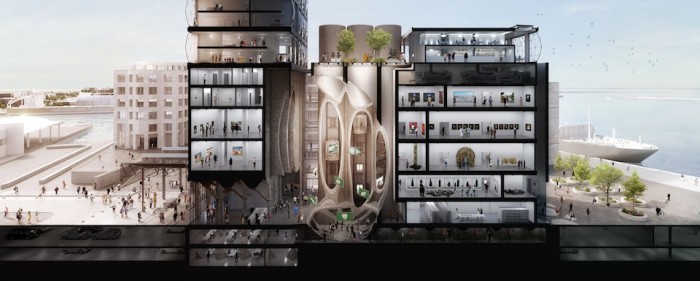
Thomas Heatherwick was back in Cape Town last week to launch the commencement of the R500-million redevelopment project that will showcase one of the largest contemporary African art collections in the world.
“Today is the beginning of major making,” Heatherwick said in the Allan Gray building auditorium at the Victoria & Alfred Waterfront, an office building designed by one of the South African architectural firms hired to deliver what Heatherwick has envisaged for the grain silo next door, to house the Zeitz Museum of Contemporary Art Africa (Zeitz MOCAA).
“Making has been a major motivation for me since I was little,” Heatherwick said, in reference to the name of his book, Making, which the Waterfront’s management company chief executive David Green had mentioned in his introduction for the London-based designer.
Earlier in the evening, an assembled group including Richard Brasher, the chief executive of Waterfront anchor tenant Pick n Pay; the architect who designed the original shopping centre at the Waterfront, Louis Karol; MOCAA Zeitz curator Mark Coetzee and the museum’s benefactor Jochen Zeitz, was led into the grain silo, white hard hats on heads, for the last public viewing before it becomes a construction site proper, when forty-two 33-metre high concrete tubes transform into a world-class art viewing facility. As part of the ceremony, a praise singer blessed the building.
Zeitz, who first met Coetzee in Miami where Coetzee was living and working at the time, said the purchase of new works and the commissioning of “significant, big pieces” had already begun in anticipation of the museum, which is due to be completed in September 2016 and to open in March 2017.
When Zeitz saw the grain silo for the first time, he had said: “Oh my god, this is it.” “And usually when I react like this, things start to happen pretty quickly,” he added.
The Zeitz Collection has been in the making for 10 years. “I collect for a reason. I wanted to give artists from Africa an opportunity to represent themselves. Art changes the world. It evolves us, it improves us, it challenges us everyday.”
Heatherwick's involvement was 'a sign that this will be grand and significant'. And that 'grand art, art that shines' will have the space to breathe there.
Green said 700 items salvaged from the building would be repurposed in the redevelopment, including now non-operational bits of machinery that would be integrated into the design to remind people of the silo’s former function.
Heatherwick said that once the “gloop” had been taken off the historical concrete, including the “magnolia veil” – or paint the colour of granny’s tights, as he also described it – there were gems of stone to be found in the concrete, sparkling like blue jewels.
“The thing about this building is that it doesn’t have flaws in it.” It has, he said, to quote Le Corbusier, the raw power and clarity of an industrial building.
If you cut through at an angle, those tubes suddenly danced. It’s going to be something that hasn’t been done before, by anyone.
Heatherwick first spoke at the Design Indaba Conference nine years ago, on the same trip he was introduced to the grain silo and given a tour of it. While the redevelopment project was announced in November 2013 as a partnership between the Waterfront and Zeitz, Heatherwick announced his involvement and for the first time revealed the details of the design when he returned to speak at the Design Indaba Conference in February of this year.
Last week, while showing computer-aided design and drafting illustrations of how the interior will look – complete with actual artwork-curated rooms by Coetzee – he spoke of countries like China where benefactors were building museums before they had anything to put in them.
“This is happening in a rare way and the right way round.”






